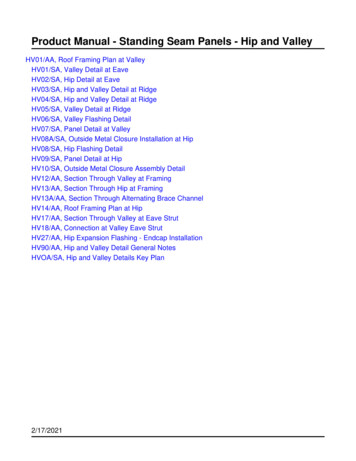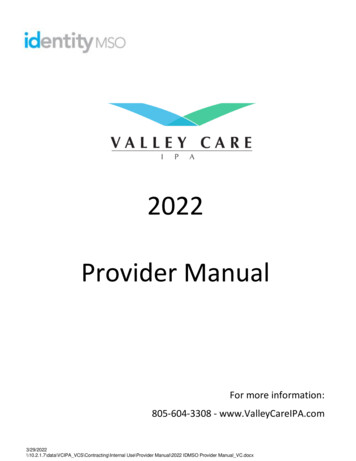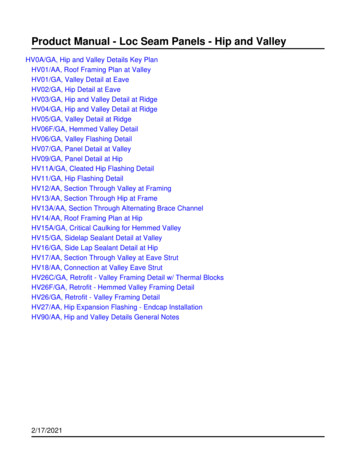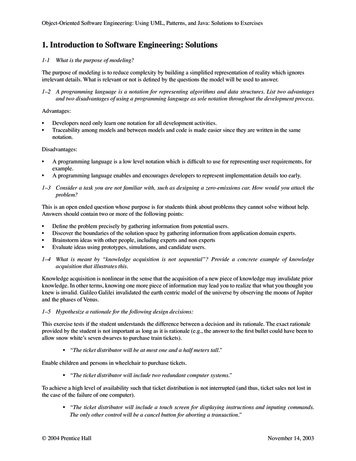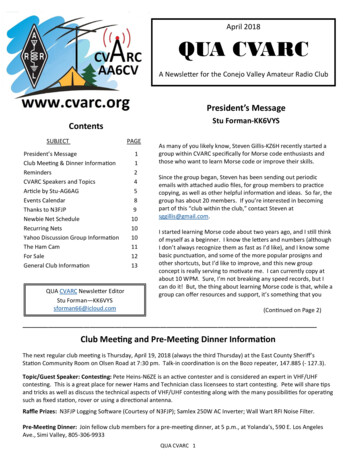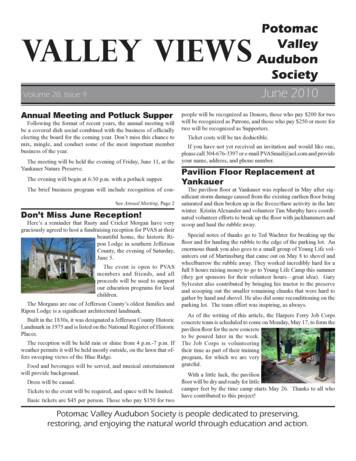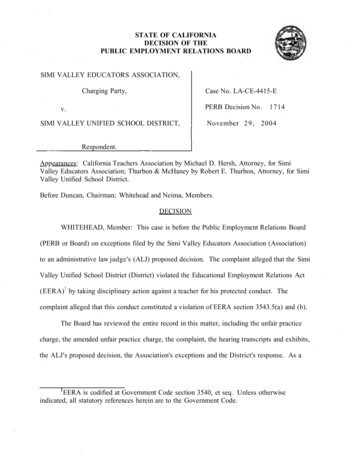
Transcription
STATE OF CALIFORNIADECISION OF THEPUBLIC EMPLOYMENT RELATIONS BOARDSIMI VALLEY EDUCATORS ASSOCIATION,Charging Party,Case No. LA-CE-4415-EPERB Decision No.v.SIMI VALLEY UNIFIED SCHOOL DISTRICT,1714November 2 9 , 2004Respondent.Appearances: California Teachers Association by Michael D. Hersh, Attorney, for SimiValley Educators Association; Thurbon & McHaney by Robert E. Thurbon, Attorney, for SimiValley Unified School District.Before Duncan, Chairman; Whitehead and Neima, Members.DECISIONWHITEHEAD, Member: This case is before the Public Employment Relations Board(PERB or Board) on exceptions filed by the Simi Valley Educators Association (Association)to an administrative law judge's (ALJ) proposed decision. The complaint alleged that the SimiValley Unified School District (District) violated the Educational Employment Relations Act(EERA) ! by taking disciplinary action against a teacher for his protected conduct. Thecomplaint alleged that this conduct constituted a violation of EERA section 3543.5(a) and (b).The Board has reviewed the entire record in this matter, including the unfair practicecharge, the amended unfair practice charge, the complaint, the hearing transcripts and exhibits,the ALJ's proposed decision, the Association's exceptions and the District's response. As aEERA is codified at Government Code section 3540, et seq. Unless otherwiseindicated, all statutory references herein are to the Government Code.
result of our review, the Board finds a violation of EERA section 3543.5(a) and (b)2 andreverses the ALJ's proposed decision.BACKGROUNDMike Bishop (Bishop) has been a full-time social science teacher at the District'sApollo School (Apollo) for 21 years and was an Association site representative for at leastthree years before the events at issue. Before that, he worked as a Catholic missionary inAfrica for nearly 20 years. In April 2001, Apollo Principal Nidia Grijalva-Imbler (GrijalvaImbler) wrote a glowing recommendation for Bishop to become a "consulting teacher," aposition in which he would share his expertise as an educator to assist other teachers who weredeemed in need of assistance. In Bishop's June 2001 performance evaluation, Grijalva-Imblerrated him highly.Apollo is a continuation school to which students are referred because of behavior,attendance or social problems. As a site representative, Bishop maintained an informationflow between the Association and employees, and represented employees about to bedisciplined by the District. Along those lines, at the request of Grijalva-Imbler, he attended ameeting on November 14, 2001, as site representative on behalf of a fellow teacher. OnEERA section 3543.5 states, in pertinent part:It is unlawful for a public school employer to do any of thefollowing:(a) Impose or threaten to impose reprisals on employees, todiscriminate or threaten to discriminate against employees, orotherwise to interfere with, restrain, or coerce employees becauseof their exercise of rights guaranteed by this chapter. Forpurposes of this subdivision, "employee" includes an applicantfor employment or reemployment.(b) Deny to employee organizations rights guaranteed to them bythis chapter.22
February 8, 2002, he represented teacher and former site representative Nancy Lee (Lee)whose performance the principal had criticized. Bishop also attended Associationrepresentative council meetings.The Program DisputeOn October 1, 2001, at a weekly staff meeting, Grijalva-Imbler asked that staff vote ona proposal for students to earn extra credit through an independent study program (program).The program had not been formally discussed until the October 1 staff meeting. After a heateddiscussion, most teachers voted in favor of the program except for Bishop, Lee, and one or twoother teachers. Bishop's concerns involved mandatory participation in the program and theprovision of undeserved extra credit to students. On October 2, 2001, Bishop sent a memo toGrijalva-Imbler and two school counselors outlining his objections to the program.After the October 1 meeting, Association Staff Representative Hal Vick (Vick) askedBishop about the program after learning about it from another teacher. Bishop expressed hisconcerns to Vick about the program believing that the program was not voluntary for teachersand that students might be granted undeserved credit. Vick stated that other teachers wereconcerned about the undeserved extra credit but believed that the Association's only legitimateconcern was whether participation by teachers was voluntary. Vick contacted Dr. Cary Dritz(Dritz), the District's assistant superintendent of personnel services, and the two scheduled ameeting for October 30, 2001, a day off for the teachers. Dritz was to invite Grijalva-Imblerand he thought that Vick would invite Bishop. Dritz invited Grijalva-Imbler and told her tobring a couple of teachers. After the meeting, Vick asked Bishop about the program afterlearning about it from another teacher. Bishop expressed his concerns to Vick about theprogram believing that the program was not voluntary for teachers and that students might begranted undeserved credit. He told her some teachers were intimidated by the program dispute.w3
Grijalva-Imbler was shocked to hear this, thinking that a consensus had been reached and thatshe did not want the program "sabotaged." Vick was unaware that Grijalva-Imbler wasbringing other teachers to the meeting. Because of some "misunderstanding," Vick did notinvite Bishop to the meeting. Grijalva-Imbler brought nine teachers to the meeting.At the meeting, the attendees agreed that teachers' participation in the program wasvoluntary. Vick was concerned by Grijalva-Imbler's reaction to the Association's challenge tothe program and by the number of teachers she brought to the meeting that there may beretaliation against Bishop. After the meeting, Vick called Bishop and told him what occurredat the meeting, that he should "be careful" if confronted about his opposition by his coworkers,and that the Association would protect him. From this conversation, Bishop assumed thatGrijalva-Imbler had intentionally picked teachers who supported the program and that he hadbeen deliberately excluded.While both were registering students, Bishop confronted Grijalva-Imbler about the"secret meeting." Grijalva-Imbler responded that the meeting was a result of Bishop filing agrievance over the program. Bishop assured her that there was no grievance; but, GrijalvaImbler explained that perhaps she had used the wrong term and that she knew he hadcomplained about the program to the Association. This encounter was hostile in that voiceswere raised. Bishop also testified that Grijalva-Imbler stated that, "You have your people, Ihave mine."By memo dated October 30, 2001, Bishop wrote to Grijalva-Imbler expressing hisdismay at being falsely accused of filing a grievance. Grijalva-Imbler did not respond buttestified that she was upset by the substance of the memo. Not having received a response,Bishop wrote a memo to Apollo staff in which he explained that he had never filed a grievanceagainst Grijalva-Imbler and that he considered the Monday meeting had been an "ambush and4
an attempt to drive a huge wedge down the middle of our staff." He also stated that consensusbuilding and the group decision process "are destroyed by such an underhanded approach toleadership."To resolve the dispute, on November 6, Bishop, Grijalva-Imbler, Dritz and Vick met inDritz' office. Dritz and Vick told Bishop that they had set up the October 30 meeting, notGrijalva-Imbler, and that Bishop was not invited because of a misunderstanding, for whichVick apologized. The participants then discussed their positions on the program. At the end,Grijalva-Imbler drafted a memo approved by Bishop to all Apollo teachers entitled, "Clear theAir," which was distributed at a staff meeting the next day. The memo stated that there weresome misunderstandings, that the November 6 meeting was very productive, and that Districtpolicy regarding participation in the program was voluntary. The memo ended by invitingteachers with concerns to discuss them with Grijalva-Imbler, the Association, or both together.Although the conflict between Bishop and Grijalva-Imbler was resolved, both testified thatthey believed that the other was still angry.Deterioration of Bishop's/Griialva-Imbler's RelationshipSince the resolution of the dispute, Bishop believes that his relationship with GrijalvaImbler has deteriorated. For example, there was an incident in which Bishop reported studentsto Grijalva-Imbler for using drugs. The next day Grijalva-Imbler wrote him a memo asking ifhe knew what he was talking about. Bishop contends that he was left out of staff discussionswith the principal, in which he used to participate, and that she stopped talking to him. Bishopalso contends that there was a division between those who attended the October 30 meetingand those who did not attend, but this was not explained. Grijalva-Imbler also began to visithis classroom unannounced and without apparent reason. Bishop and Sue Rosenfeld(Rosenfeld), his instructional aide, testified that Grijalva-Imbler's conduct caused his students5UI
to comment and joke that he was in trouble. In the past, Grijalva-Imbler had visited for aspecific purpose, normally to speak with Bishop, entered the front door and greeted Bishop.After the October/November events, she entered through an accordion door from an adjoiningclassroom and did not greet or speak to Bishop, Rosenfeld or the students. Bishop estimatedthat Grijalva-Imbler visited his classroom at least 40 times, often lasting 10 to 12 minutes,between October 2001 and April 2002. The length and frequency of these visits far exceededhis previous experience. Other teachers testified that when Grijalva-Imbler visited theirclassroom often, she followed up by offering suggestions. Grijalva-Imbler testified that shenever discussed her alleged concerns with Bishop arising from her observations and neverattempted to do so until the April 8, 2002 memo.On April 8, 2002, Bishop received a note from Grijalva-Imbler requesting that he meetwith her on April 10 "to discuss some student concerns." Bishop responded by note datedApril 9, requesting the names of the students and asking whether the concerns were from thestudents or Grijalva-Imbler. Bishop also stated that he would not meet with Grijalva-Imblerwithout union representation. Bishop called the Association office for assistance.Grijalva-Imbler contacted Dritz regarding Bishop's request for representation. Dritztestified that Grijalva-Imbler was frustrated that Bishop refused to meet with her without unionrepresentation. Dritz advised her that if the meeting was not an evaluative meeting or adisciplinary meeting, she could "give that in a memo or you can basically direct him to cometalk to you. It doesn't require representation." He testified that he also told her, "you could,you know, take the time and wait for him to have a representative. That would be a fair thingto do because he's requesting that." Grijalva-Imbler told Dritz that the meeting involved aconcern with Bishop's teaching methods and that she wanted Bishop to provide additionalinstruction in order to comply with new state standards. Grijalva-Imbler assured Dritz that the66
meeting was not disciplinary. Though Grijalva-Imbler sent Dritz a draft of the April 9 memofor review, the draft that Dritz reviewed did not contain the dates of proposed classroom visits.Grijalva-Imbler then wrote Bishop a memo dated April 9, 2002, in which she expresseddisappointment that Bishop would not meet with her and had hoped that their differences wereresolved. The memo discussed student uneasiness about his classes because of the way it wasstructured and would like to see him more frequently presenting information orally andvisually. She wrote that she planned to visit his classes 26 times in the next two monthsbeginning April 17, 2002. On April 16, 2002, Bishop took a medical leave of absence because"I cannot work with the needy kids that we work with at Apollo, in such a hostile workingenvironment. Watching my back while I'm trying to meet the needs of these students."Bishop also suffers from a medical condition called esophageal spasm which causes himsevere chest pain. As a result, school staff, including Grijalva-Imbler, assisted him by seekingemergency medical assistance. He did not feel he could rely on Grijalva-Imbler any longer.As a result, he also resigned his position as department chair, a position he had held for fouryears.There was much testimony regarding how regularly Grijalva-Imbler visits otherteachers; however, none was anywhere near the 26 proposed visits to Bishop's classes in twomonths. There was testimony from both the Association and the District regarding thecoolness in the relationship between Bishop and Grijalva-Imbler.Grijalva-Imbler testified that she has been concerned about Bishop's teaching methodsfor sometime. She states that he uses an independent study approach, having studentscomplete assignments, rather than making oral and visual presentations to class.However, Grijalva-Imbler's write-ups of Bishop's performance did not raise theseperformance issues. Instead, e.g., the April 27, 2001 written recommendation for the77
consulting teacher position described Bishop as an "exemplary teacher" and further elaboratedabout his teaching skills in glowing terms. This recommendation also discussed his experienceas a mentor to new teachers. In the June 2001 performance evaluation, Grijalva-Imbler statedthat:Mike uses formal and informal assessment to modify his teachingand meet the students' needs. Mike meets individually withstudents to evaluate their progress and give them feedback inregards to their achievement.At the end of the evaluation, Grijalva-Imbler suggested that Bishop continue to collaboratewith Mary Beth Bellotti (Bellotti), his performance evaluation partner. Grijalva-Imblertestified at the hearing that she was hoping that this last comment would help Bishop improvehis performance; however, that is not clear from either the content of the evaluation itself orfrom Bishop's testimony.ALJ'S PROPOSED DECISIONThe Association alleged interference and retaliation against Bishop for exercise of hisprotected rights. With regard to protected rights, the ALJ found that Bishop refused to meetwith Grijalva-Imbler "for any sort of meeting, without representation." The ALJ stated that thelaw is well-settled that there is no right to union representation unless the meeting involves aninvestigatory interview reasonably anticipated to result in discipline (Rio Hondo CommunityCollege District (1982) PERB Decision No. 260; Berkeley Unified School District (2002)PERB Decision No. 1481), or unusual and intimidating circumstances (Redwoods CommunityCollege District v. PERB (1984) 159 Cal.App.3d 617 [205 Cal.Rptr. 523]). The ALJ did notbelieve Grijalva-Imbler's April 8 note or the proposed April 10 meeting to fit thesedescriptions.88
However, the ALJ did find that Bishop engaged in protected activity when herepresented fellow teachers in meetings with the principal in November 2001 and February2002, when he discussed with other employees his opposition to the program in September andOctober 2001, as well as his October 2 memo to Grijalva-Imbler about the program.According to the ALJ, teachers' concerns about involuntary assignment to the program affectsworking conditions and hours.The ALJ further found that Grijalva-Imbler was obviously aware of these activities. Inaddition, she mistakenly believed that Bishop had filed a grievance against her with Vick, anact which would also be protected.The ALJ found that the excessive proposed number of visits to Bishop's classes byGrijalva-Imbler and the amount of time she would need to stay to evaluate his use ofalternative teaching strategies evidenced disparate treatment of Bishop and a deviation fromher standard visitation practices. Her claims about Bishop's teaching methods werecontradicted by the favorable performance evaluation in April and June 2001 and the fact thatshe had not alleged any comments before the occurrence of the events at issue.Despite these findings, the ALJ did not find nexus. The ALJ determined that the timingwas off. Allegedly Bishop and Grijalva-Imbler had aired their differences on November 6,2001 and jointly issued the "Clear the Air" memo to teachers the next day. Although thereremained some distrust, there is no evidence that Grijalva-Imbler continued to believe thatBishop filed a grievance against her. Bishop's claims that Grijalva-Imbler visited hisclassroom more often between October 2001 and April 2002 lacks specificity as to frequency.There is no evidence of anti-union animus or of negative reaction to Bishop's representation ofthe two teachers in November 2001 and February 2002, the earlier of which was at GrijalvaImbler's request. The six-month span between Bishop's opposition to the program and99
Grijalva-Imbler's April 2002 memoranda are too remote to infer unlawful motive. The ALJdid not find sufficient nexus between Bishop's protected activity and Grijalva-Imbler'sproposed 26 visits to his classroom or cancellation of the April 10 meeting. With regard to thelatter, the ALJ found that a valid option of Bishop's refusal to meet with Grijalva-Imblerwithout representation was to follow Dritz' suggestion to put her concerns in writing.The ALJ found that Grijalva-Imbler's cancellation of the April 10 meeting did notcomprise "adverse action" under the objective test in Newark Unified School District (1991)PERB Decision No. 864.The ALJ therefore found no violation and dismissed the underlying charge.DISCUSSIONTo demonstrate a violation of EERA section 3543.5(a), the charging party must showthat: (1) the employee exercised rights under EERA; (2) the employer had knowledge of theexercise of those rights; and (3) the employer imposed or threatened to impose reprisals,discriminated or threatened to discriminate, or otherwise interfered with, restrained or coercedthe employees because of the exercise of those rights. fNovato Unified School District (1982)PERB Decision No. 210 fNovato*): Carlsbad Unified School District (1979) PERB DecisionNo. 89.)Although the timing of the employer's adverse action in close temporal proximity to theemployee's protected conduct is an important factor (North Sacramento School District (1982)PERB Decision No. 264 (No. Sacramento)), it does not, without more, demonstrate thenecessary connection or "nexus" between the adverse action and the protected conduct.(Moreland Elementary School District (1982) PERB Decision No. 227.) Facts establishing oneor more of the following additional factors must also be present: (1) the employer's disparatetreatment of the employee (State of California (Department of Transportation) (1984) PERB10
Decision No. 459-S); (2) the employer's departure from established procedures and standardswhen dealing with the employee (Santa Clara Unified School District (1979) PERB DecisionNo. 104); (3) the employer's inconsistent or contradictory justifications for its actions (State ofCalifornia (Department of Parks and Recreation) (1983) PERB Decision No. 328-S); (4) theemployer's cursory investigation of the employee's misconduct; (5) the employer's failure tooffer the employee justification at the time it took action or the offering of exaggerated, vague,or ambiguous reasons; (6) employer animosity towards union activists (Cupertino UnionElementary School District (1986) PERB Decision No. 572); or (7) any other facts whichmight demonstrate the employer's unlawful motive. (Novato; No. Sacramento.)Evidence of adverse action is also required to support a claim of discrimination orreprisal under the Novato standard. (Palo Verde Unified School District (1988) PERBDecision No. 689.) In determining whether such evidence is established, the Board uses anobjective test and will not rely upon the subjective reactions of the employee. (Ibid.) In a laterdecision, the Board further explained that:The test which must be satisfied is not whether the employeefound the employer's action to be adverse, but whether areasonable person under the same circumstances would considerthe action to have an adverse impact on the employee'semployment. [Newark Unified School District (1991) PERBDecision No. 864 (Newark); emphasis added; fn. omitted.]Protected ConductWe find that Bishop engaged in protected conduct. There is no dispute that Bishophad been the Association site representative for at least three years prior to the incidents atissue. He represented co-workers in meetings with Grijalva-Imbler in November 2001 and inFebruary 2002, the former meeting at Grijalva-Imbler's request. Vick testified that theFebruary 2002 meeting at which he and Bishop represented Lee was very contentious. There11
is also no dispute that Bishop's efforts to challenge the program, i.e., his protests at theOctober staff meeting; his October 2, 2001 memo to Grijalva-Imbler explaining the historicproblems with independent study programs; his discussions of the program with Vick; and hisparticipation in the November 6 meeting are protected activity. (Regents of the University ofCalifornia (Einheber) (1992) PERB Decision No. 949-H; Madera County Office of Education(1999) PERB Decision No. 1334.)What is in dispute is whether his request for representation in response to the April 8note from Grijalva-Imbler is protected. The Association argues that the request itself isprotected conduct notwithstanding whether he was entitled to representation under thecircumstances in this case. The District agrees with the proposed decision that the Aprilrequest was not protected because Bishop was not entitled to representation under thecircumstances. The District appears to confuse Weingarten3 rights with the protected natureof the request for representation itself. The Board has long held that requests for unionrepresentation to discuss working conditions, such as job assignments, are protected conduct.(See e.g., Los Angeles Unified School District (1991) PERB Decision No. 874; CaliforniaState University. Long Beach (1987) PERB Decision No. 641-H; California State University.Sacramento (1982) PERB Decision No. 211-H.) We find that Bishop's request forrepresentation for the proposed April 10 meeting to be protected conduct.Employer Knowledge of Protected ConductIt is undisputed that the District was aware of Bishop's protected conduct.Adverse Action3In National Labor Relations Board v. Weingarten (1975) 420 U.S. 251 [88 LRRM2689] (Weingarten), the Court granted employees the right to representation duringdisciplinary interviews.12
The Association asserts that Grijalva-Imbler imposed adverse action beginning soonafter the October and November meetings through her silent, frequent and unannounced visitsto his classroom, which culminated in the April 9 memo to Bishop imposing 26 hours ofobservation in a 2 month period. The ALJ determined Grijalva-Imbler's cancellation of theApril 10 meeting -not to comprise adverse action.As noted, the Board uses an objective test to establish adverse action. There was muchtestimony over the number, frequency and tenor of Grijalva-Imbler's visits to teachers'classrooms by teacher/witnesses during the hearing. The experience of these teachers wassignificantly different in number and tone than Bishop's experience with Grijalva-Imbler'svisits. Compared with Bishop, Teacher Vince Deblahovich (Deblahovich) testified thatGrijalva-Imbler visited him "a lot," which he described as once every two weeks.Deblahovich also expressed surprise at the number of visits proposed in the April 9 memo.Teacher Renee Griser, a District witness, testified that Grijalva-Imbler visited her classrooman average of twice a week for a couple of minutes each and that occasionally they woulddiscuss classroom issues. She had only received a written notice of observation when it wastime for her formal evaluation, which occurred every other year. Teacher Cristina Sullivan(Sullivan), a District witness and teacher for parenting teenagers, testified that Grijalva-Imblervisited her classroom 12 to 14 times in a quarter (approximately 10 weeks) or slightly moreoften than once per week. Sullivan stated that Grijalva-Imbler's demeanor was always veryfriendly, that she always says hi to staff aides, and talks to the students, and their babies. Shestays from 5 to 10 minutes each time. Special Education Teacher, Bellotti, another Districtwitness, testified that in a quarter, Grijalva-Imbler observes her class probably 12 to 15 timesand stays 2 to 5 minutes. Bellotti described these informal observations as "friendly and easygoing."13
Bishop's experience with Grijalva-Imbler's visits after October 2001 was significantlydifferent than his experience before then. Bishop testified, and Grijalva-Imbler confirmed inher testimony, that between October and the beginning of April, Grijalva-Imbler visitedapproximately 40 times.4 Before that, other than his formal observation, which occurs everyother year, Grijalva-Imbler only visited Bishop sporadically, specifically to ask him aquestion or inform him of something he needed to know, greeted him, came through the doorand was always friendly. After October 2001, the visits were frequent, Grijalva-Imbler wouldenter Bishop's classroom through the accordion wall separating an adjoining classroom andwould not speak. Both Bishop and his instructional aide, Rosenfeld, testified that the changein frequency and tone of Grijalva-Imbler's visits after October 1 prompted students tocomment why she visited so often and to ask whether Bishop was "in trouble." These monthsof silent visits culminated in the April 9 memo critical of his teaching methods and scheduling26 hours of observation over a two-month period beginning April 17. At the hearing,Grijalva-Imbler was asked about her normal observation procedures. She stated that whenshe visited and observed an issue that needed correction or a different approach, she wouldsoon speak to the teacher privately. She acknowledged that during all these months of visitsshe never shared her "concerns" with Bishop even privately and when asked why, respondedwith a series of non-answers. Vick testified that, in his years as an Association representative,he had not seen a memo requiring the number of visits as proposed in the April 9 memounless the teacher was in trouble. Bishop testified likewise. Assistant Superintendent ofPersonnel Services Dritz testified that he had only seen that number of visitations over theThe proposed decision stated that the Association did not provide testimony as to thenumber of these visits. However, Bishop testified to an estimate of 40 visits. The District didnot dispute this number; rather, in her testimony, Grijalva-Imbler strongly agreed to visitingBishop at least that many times during this period.14
short period of time when working with consulting teachers.5 Utilizing the objective testunder Newark, comparing the atmosphere and the frequency of Grijalva-Imbler'sobservations of Bishop and the frequency and length of those classroom visits proposed in theApril 9 memo with her treatment of other teachers during informal observations, we concludethat a reasonable person "under the same circumstances would consider the actions (takenagainst Bishop) to have an adverse impact on (Bishop's) employment."6NexusWe further conclude that the Association has demonstrated a nexus between theprotected conduct and the adverse action. The Board has held that an employer actsunlawfully if it retaliates against an employee in the mistaken belief that the employee hasengaged in protected activity. (California Union of Safety Employees (John) (1994) PERBDecision No. 1064-S, citing Pleasant View Rest Home (1971) 194 NLRB 426 [78 LRRM1683]; NLRB v. Link-Belt Co. (1941) 311 U.S. 584 [7 LRRM 297].) On several occasions,Grijalva-Imbler expressed, and other teachers parroted, their mistaken belief that Bishop hadfiled a grievance about the program. Before October 2001 when the Association challengedthe program, Grijalva-Imbler and Bishop had a professional relationship; her classroom visitswere sporadic but communicative and friendly. During and after the October/November 2001events, Grijalva-Imbler visited Bishop's classroom at least 40 times for at least 10 to 12minutes each time from the adjoining classroom without explanation or greeting.7 TheseConsulting teachers assist, observe and report on "teachers in trouble."6We will not speculate whether the cancellation of the April 10 meeting comprisesadverse action. The tangible actions taken by Grijalva-Imbler involve the observations sinceOctober 2001 and the content of the April 9 memo.7Bishop testified that he would occasionally say "hi" but gave up after repeatedlygetting no response.15
classroom visits culminated in the April 9 memo. Grijalva-Imbler wrote the April 9 memocritical of Bishop's teaching style and scheduling 26 classroom observations in a two-monthperiod. This memo was written immediately after Bishop had requested union representationfor the proposed April 10 meeting. Since the silent observations began in October, the memowas the first time that Grijalva-Imbler expressed her concerns to Bishop about his teachingmethods. Instead of assuring Bishop that the April 10 meeting would not be disciplinary,Grijalva-Imbler wrote the April 9 memo. Although Grijalva-Imbler claims that AssociateSuperintendent Dritz approved the April 9 memo, he had only approved a draft that wasmissing the 26 proposed classroom observations. The advice Dritz gave to Grijalva-Imblerwas premised on Grijalva-Imbler's assurances that the meeting was not investigatory ordisciplinary in nature. Dritz advised Grijalva-Imbler that she might wait to meet wi
SIMI VALLEY EDUCATORS ASSOCIATION, Charging Party, v. SIMI VALLEY UNIFIED SCHOOL DISTRICT, Respondent. Case No. LA-CE-4415-E PERB Decision No. 1714 November 29, 2004 Appearances: California Teachers Association by Michael D. Hersh, Attorney, for Simi Valley Educators Association; Thurbon & McHaney by Robert E. Thurbon, Attorney, for Simi




